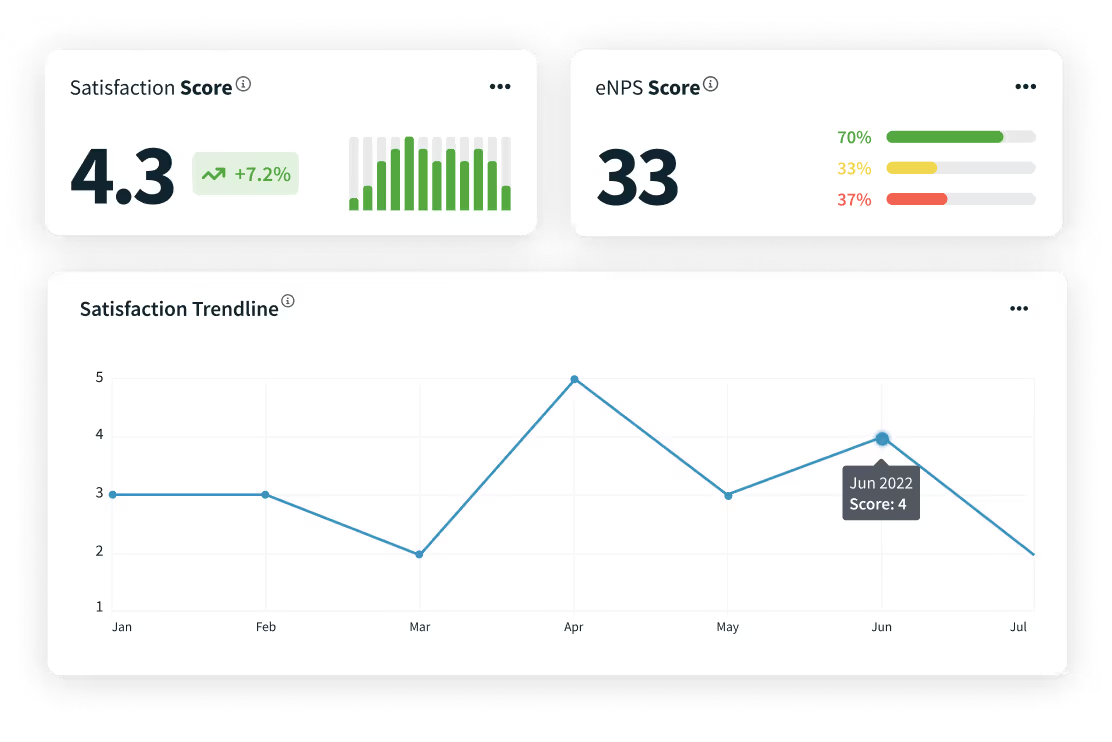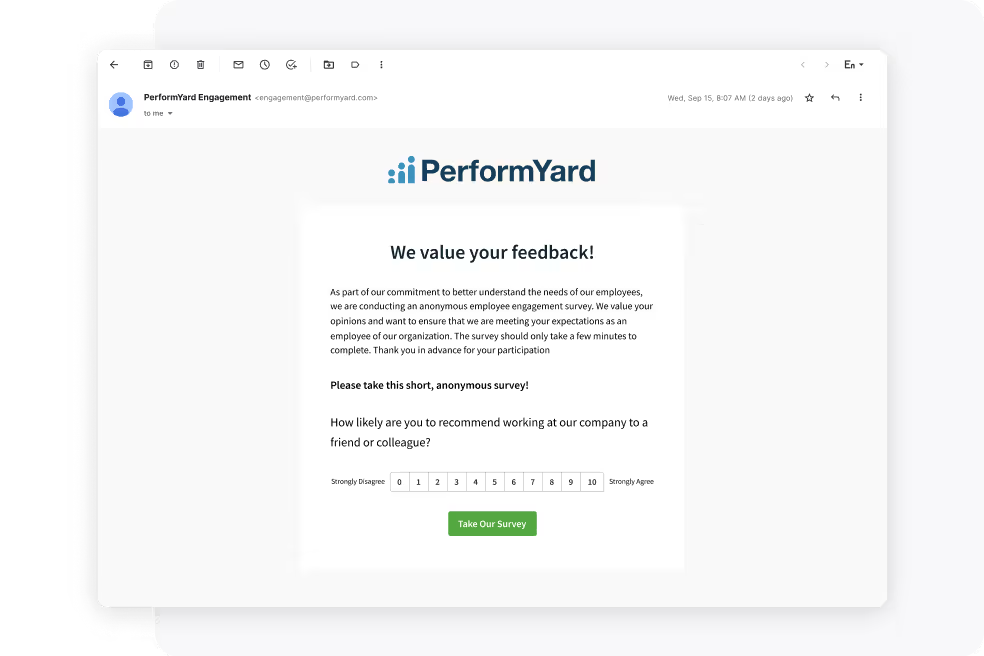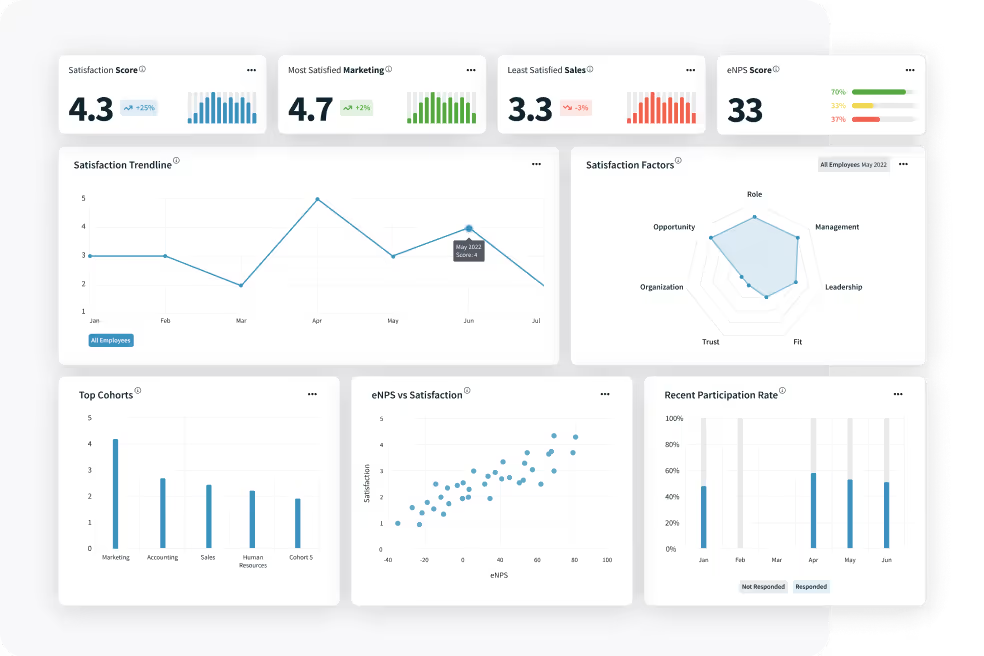eNPS: What is Employee Net Promoter Score and Why Does it Matter?
eNPS or employee net promoter score is a critical metric that your HR org can use to measure how satisfied your employees are with their jobs and how likely they are to recommend your company to others.
But how do you calculate eNPS? Why is eNPS important? How can you measure eNPS?
You’ve come to the right place. We’re here to help guide you through everything eNPS – from definition to calculation to measurement. By the end of the article, you’ll not only know how your promoters from your detractors, but you’ll also have a good grasp on how to deliver an eNPS survey that will accurately measure employee satisfaction.
Let’s jump in.
What does eNPS mean?
eNPS stands for Employee Net Promoter Score. It is a metric that determines how satisfied your employees are at your company by measuring how likely they are to recommend your company to others.
eNPS is based on NPS – or Net Promoter Score – which is a metric used to determine customer satisfaction. With eNPS, you’re measuring employee satisfaction.
The eNPS scale is an invaluable tool for HR professionals and business managers aiming to gauge the loyalty and engagement of their employees. Understanding this scale is crucial, as it ranges from -100 to +100, providing a straightforward mechanism to interpret employee sentiment.
Understanding the eNPS Scale
The eNPS or Employee Net Promoter Score is derived from responses to a single eNPS question: 'On a scale from 0 to 10, how likely are you to recommend our company as a place to work?' This scale results in scores that can range from -100, indicating all respondents are detractors, to +100, if all are promoters.
Interpretation of Scores
A negative eNPS score suggests that there are more detractors than promoters, indicating dissatisfaction among your workforce. A neutral score indicates a balance between promoters and detractors, while a positive score reflects more promoters, suggesting that employees are satisfied and are strong advocates for your company.
Common outcomes vary widely across the scale. Organizations typically aim for scores in the positive range, as they indicate a healthy company culture and a supportive working environment. However, recognizing where your organization fits on the eNPS scale can set the groundwork for strategic improvements and reinforcements of your HR practices.

How is eNPS calculated?
eNPS is measured by first asking employees to answer a simple question:
Q: On a scale of 0-10, with 0 being “not at all” and 10 being “without hesitation,” how likely would you be to recommend working for our company?
Responses are then divided into three categories:
9-10: promoters
7-8: passives
0-6: detractors
To calculate eNPS, you first subtract the number of detractors from promoters, and then divide that number by the total number of respondents. Then you multiply that number by 100 to get the final number.
(Promoters – Detractors) / Total Participants X 100 = eNPS
Let’s try out an example.
You surveyed 200 people at your company. 60 of them were promoters, 120 of them were passives, and 20 were detractors.
(60 – 20) / 200 X 100
(40) / 200 X 100
0.2 X 100
20.
In this case, the eNPS would be 20.
What are Promoters, Passives, and Detractors in eNPS?
Surveyed employees are classified as promoters, passives, or detractors – depending upon their answers to the eNPS survey.
Remember, in the eNPS survey, employees are asked to rate (on a scale of 0-10) how likely they would be to recommend your company.
9-10: promoter
7-8: passive
0-6: detractor
Promoters
Promoters are employees who would be very likely to recommend your company. They are folks who are highly engaged in their work, believe in the company values, and consistently create high-quality output. They are a net benefit to your company.
Promoters, as their name would suggest, promote your company’s image. They attract top-tier talent.
Passives
Passives are employees who are satisfied, but not highly engaged with their work. They are susceptible to leaving for better offers that more accurately align with their needs – be it for compensation, work-life balance, benefits, or values.
Detractors
Detractors are employees who are dissatisfied with your organization. These employees are looking to leave – and will leave as soon as a better opportunity arises. These employees will typically speak negatively about your organization, which will reduce the likelihood of you gaining top-level talent.
It is critical to keep the level of detractors as low as possible to gain and retain high-level performers at your organization.
What is a good eNPS?
Determining what qualifies as a good eNPS score is essential for evaluating employee satisfaction and guiding your strategy towards improving workplace culture. An eNPS score can range from -100 to +100. Generally, a score above 0 is considered positive, indicating that there are more promoters than detractors in your organization. However, understanding the nuances of what makes a score good requires deeper insight.
Ideal eNPS Scores and Their Implications
A score between 10 and 30 is often regarded as acceptable, showing a fair level of employee satisfaction and modest employee loyalty. Scores ranging between 30 and 50 are quite strong, symbolizing a healthy workplace that most employees would recommend. Any score above 50 is excellent, highlighting truly outstanding team morale and engagement. These scores suggest a thriving company culture where employees are eager advocates for the organization.
Comparing eNPS Scores Across Industries and Regions
Different industries and regions report varying eNPS benchmarks. For instance, tech companies may achieve higher scores due to competitive salaries and innovation-driven environments. In contrast, companies in traditional manufacturing might not score as high due to different industry challenges and employee expectations. It’s important to gauge your score against similar organizations to get a meaningful indicator of your company’s standing.
Factors Affecting What Is Considered a 'Good' eNPS
Several factors impact what is considered a ‘good’ eNPS score for an organization. Company size, industry norms, cultural expectations, and specific organizational challenges should all be taken into account. Additionally, it is valuable to consider temporal fluctuations in scores, such as post-organizational changes or during fiscal crises, as these can temporarily impact employee perspectives. Therefore, a good score is also one viewed in context, through trends and benchmarks reflective of the company’s unique environment.
eNPS can go from -100 to +100. If everyone at your organization rated your company a 1, you’d have a rating of -100. If everyone rated it a 10, you’d have a score of +100.
Now, neither of those numbers is realistic. Organizations will fall much closer to the middle.
So what is a good eNPS?
A baseline for positive eNPS is any number above 0. That means that you have more promoters than detractors in your organization.
Beyond that, here are some bands for eNPS performance.
Acceptable: 1-10
Fair: 11-20
Good: 21-30
Excellent: 30-40
Outstanding: 40+
What are the benefits of measuring eNPS?
Measuring eNPS lets HR know how happy your employees are at your organization. If you have a high score, you understand that you have a high percentage of engaged employees who will help you attract more great talent. Additionally, HR statistics have shown that highly engaged employees correlate with a 23% increase in profitability.
If you have a low eNPS, you know that you have a less satisfied workforce that may leave for other opportunities, leaving you with a high turnover rate.
Ultimately, the eNPS provides you with information. We find that the eNPS is most useful when tracked over time so that you can determine whether company morale is improving or falling.
It’s up to your organization to act effectively upon the information gleaned.
Crafting an eNPS Survey: What HR must do
You know how to calculate eNPS, and you know that eNPS is critical to measuring your employees’ satisfaction. But now you have to do the hard part and create a process to collect the data you need to calculate eNPS.
The good news: it’s not as hard as it sounds. We’ve done the hard part for you – we’ve jotted down each step you’ll need to follow to roll out an eNPS survey at your company.
Here’s how to get started.
Send out your survey
Send out your eNPS survey to each of your employees, asking for their feedback. The responses must be anonymous, so you need to adopt a survey tool that will allow you to collect and collate anonymous responses.
PerformYard’s latest employee engagement tool provides out-of-the-box employee engagement tracking, letting you quickly send out hundreds of eNPS surveys at once, and then analyze the anonymous results – all without leaving the PerformYard performance management suite.

Send out your eNPS survey again
eNPS isn’t “one and done;” you need to send it out frequently to measure the trends in your eNPS rating. We find that sending out the survey once every 3-6 months provides your organization with enough data to get a clear picture of which way your eNPS rating is trending.
Analyze your data
First, you’ll need to perform your basic eNPS calculation to determine what your Employee Net Promoter Score is.
But that’s simply the tip of the iceberg.
When you invest in an employee engagement tracking tool, like PerformYard, you get access to a lot more analysis. While ensuring the data remains completely anonymous, you can break down results over time, by function, by department, and by team. This way, you can see if certain teams are eNPS “hot spots.” Conversely, you can determine which low-eNPS scoring functions you need to focus on.

Take action
Once you’ve sliced and diced your eNPS data, you need to take action to fix any negative trends or negative functions you’ve uncovered. Perhaps the sales team is unusually negative relative to the company at large. Why is that? It’s time to investigate.
Or, has the entire eNPS for the company slipped slightly but consistently over the last 18 months? It’s time to uncover why employees are less satisfied, and then make changes accordingly.
Remember, the eNPS is only a metric that gives you a snapshot of employee satisfaction. Merely measuring the eNPS won’t improve employee satisfaction. Instead, it’s a springboard that you must use to enact positive change in your workforce.
How can I raise my eNPS?
So you ran your eNPS survey and the results weren’t as high as you wanted. That’s OK! There are actions that you can take to improve your Employee Net Promoter Score. With focus, management buy-in, and a little HR ingenuity, you can boost that eNPS considerably.
Here are the steps you can take to raise your eNPS.
Take action based on feedback
Where possible, make changes. For larger, systemic issues (such as benefits or management concerns), consult with C-suite and leadership to implement changes or create plans to implement change.
Some changes aren’t going to happen overnight. However, it’s important that you actively work to make changes in response to the feedback you receive.
Rerun the survey after changes have been made
Try to run the eNPS survey every 3-6 months. This way, you’ll have enough time in between surveys to capture any employee shifts due to the changes you’ve implemented.
Once you’ve conducted your next survey, see how your score moved. Did your changes improve your score? Have new issues cropped up?
Repeat, repeat, repeat
From there, you simply need to continue the process. Run the eNPS survey to get a pulse for employee engagement, determine areas for improvement, make changes, and then measure eNPS again.
It’s a continuous, iterative process. But by investing in the eNPS process, you ultimately invest in the engagement of your employees and the success of your company.
What is the difference between eNPS and NPS?
NPS – Net Promoter Score – is a measure of how likely your customers are to recommend your business. It is a way to determine customer satisfaction.
eNPS – Employee Net Promoter Score – is a measure of how likely your employees are to recommend your business. It is a way to determine employee satisfaction.
Both measures are critical to a business’s success. A high NPS will help bring in and retain customers, whereas a high eNPS will help bring in and retain top talent.
What software can HR use to track eNPS?
Tracking eNPS isn’t as simple as asking everyone to fill out a quick email. You need dedicated software that can send out surveys, anonymize feedback, collect responses, and analyze data.
PerformYard provides an out-of-the-box Employee Engagement tool that provides Engagement surveys, eNPS scores, reporting, and visualizations.
With PerformYard’s engagement tool, you can:
- Track eNPS and seven other HR-backed engagement factors
- Break down data over time and by cohort
- Visualize data to clearly understand trends and pain points
The employee engagement tool gives you actionable data that you can use to drive positive change in your workplace.

Remember, the eNPS is simply a metric – one that gives you a solid understanding of employee satisfaction. Improving employee satisfaction is an iterative process that involves frequently determining eNPS and then making changes in response to feedback.
Keep your finger on the pulse of employee sentiment by adopting a dedicated employee engagement tool.





